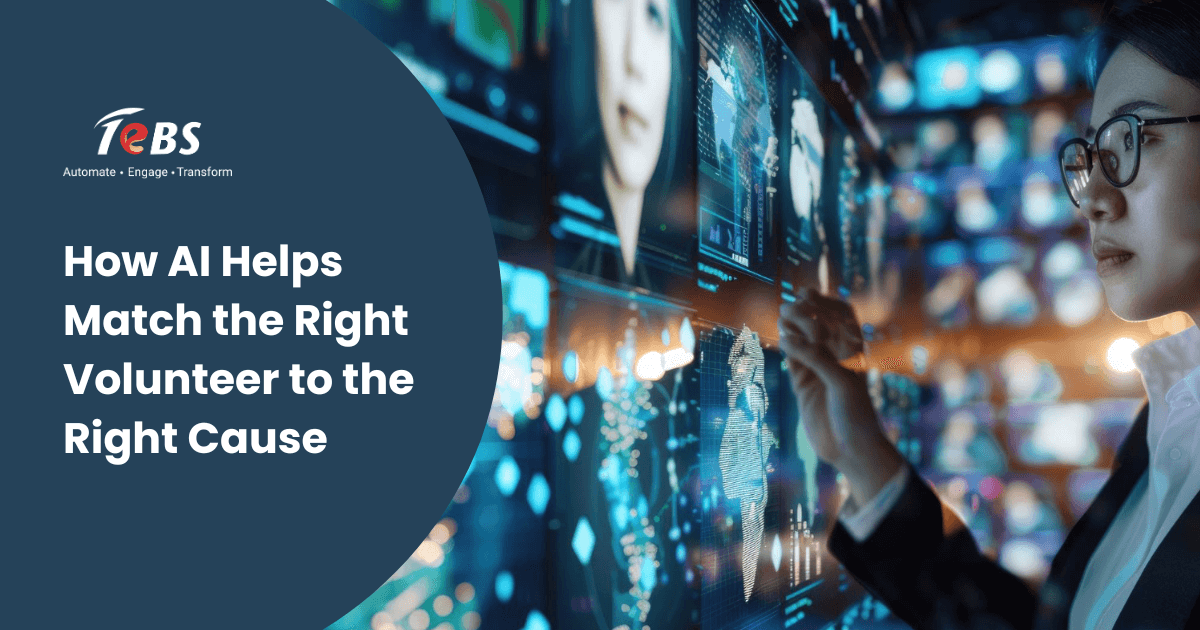Nonprofits and community-driven organizations are negotiating the growing complexity of volunteer management in today’s fast-paced digital world.
The manual volunteer assignment method, which was once common and frequently relied solely on availability, is no longer adequate.
More accurate, significant, and effective engagement is becoming more and more necessary as volunteer and organization expectations change.
Artificial intelligence (AI) is a game-changer in this regard, transforming the way organizations match the right volunteer with the right cause.
AI adds intelligence to the process rather than just automating it; it analyzes large datasets, learns from patterns in behavior, and provides insights that support data-driven decision-making for businesses.
It makes it possible to move from reactive to proactive volunteer management, guaranteeing that volunteers are not only assigned to areas where they will have the biggest impact and experience the most personal fulfillment.
Understanding the Complexity of Volunteer Matching
Volunteer management goes beyond filling roles. It’s about aligning an individual’s skills, interests, availability, values, and even emotional inclinations with the mission and needs of a specific cause. However, most nonprofits face a few common challenges:
- Limited resources to manually review each volunteer’s profile in depth
- Difficulty in keeping track of volunteer preferences and evolving interests
- Struggles in ensuring diversity, inclusion, and fairness in role assignments
- High attrition due to mismatched placements or lack of engagement
Without intelligent systems in place, matching becomes a guessing game leading to underutilized talent, missed opportunities, and volunteer dissatisfaction.
AI introduces the precision and personalization needed to address these gaps.
AI-Powered Profiling and Skill Mapping
AI begins with understanding each volunteer on a deeper level. When a new volunteer registers, intelligent systems can extract insights from their application, resume, social media profiles, previous volunteering history, and self-assessments.
Natural Language Processing (NLP) algorithms analyze text input to gauge sentiments, values, and personality traits.
Beyond surface-level data like availability and preferred cause area, AI can assess:
- Skillsets: Technical, creative, interpersonal, leadership, etc.
- Experience: Past volunteer roles and contributions
- Learning patterns: Willingness and ability to learn new tasks
- Motivations: What drives the volunteer community impact, skill-building, networking, etc.
Machine learning models map this profile against the requirements of various volunteering opportunities to recommend roles where the volunteer is most likely to thrive and make an impact.
Intelligent Opportunity Recommendations
Rather than presenting volunteers with a long list of available tasks, AI systems personalize opportunity suggestions, just as streaming platforms recommend movies or playlists.
Volunteers see roles that match not only their skills and availability but also align with their personal goals and preferences.
AI also factors in:
- Location and accessibility (if the volunteering is physical)
- Time commitment compatibility
- Preferred team dynamics solo roles vs. group efforts
- Level of challenge desired
Over time, the system learns from previous matches whether volunteers completed their assignments, gave positive feedback, or requested role changes to fine-tune its recommendations further.
Predictive Matching for Long-Term Engagement
One of the most powerful capabilities of AI lies in its predictive analytics.
Based on behavioral patterns and volunteer engagement history, AI can forecast which individuals are likely to stay committed long-term, or which causes they are likely to support more enthusiastically.
This predictive layer enables organizations to:
- Prioritize high-potential volunteers for leadership roles
- Design personalized engagement journeys
- Proactively reach out to those at risk of dropping out
- Encourage cross-cause participation by recommending related roles
Instead of reactive management, organizations can proactively nurture volunteer retention and satisfaction.
Dynamic Role Allocation During Events and Crises
Large-scale events, community drives, or emergency response scenarios require swift, dynamic volunteer deployment.
AI shines in such contexts by rapidly analyzing real-time data and deploying volunteers based on immediate needs and suitability.
For instance:
- In disaster relief, AI can prioritize volunteers with medical training, language fluency, or local familiarity.
- During large events, it can allocate volunteers based on footfall predictions, location density, and past crowd behavior.
- It can also suggest optimal schedules to avoid burnout and ensure continuous coverage.
This real-time adaptability minimizes human error and maximizes resource utilization.
Enhancing Diversity, Equity, and Inclusion
Unconscious biases often influence manual matching, even with the best intentions. AI systems, when designed ethically and responsibly, can be powerful tools to promote fairness and inclusion.
By evaluating all volunteers objectively and anonymizing certain details, AI ensures equal opportunity based on merit and alignment, rather than assumptions.
Moreover, AI can help identify underrepresented volunteer groups and recommend tailored opportunities to encourage their participation. This leads to richer, more diverse volunteer communities that reflect the spirit of inclusivity many nonprofit missions strive for.
Personalized Communication and Retention
Matching doesn’t end with placement. Volunteers who feel seen, heard, and valued are more likely to return and refer others.
AI enables nonprofits to maintain personalized, ongoing communication with volunteers based on their preferences and behavioral cues.
Examples include:
- Tailored follow-ups after events
- Automated reminders and encouragement messages
- Personalized thank-you notes with impact summaries
- Volunteer birthday or milestone recognition
Such engagement deepens relationships and builds a sense of belonging within the organization.
Reducing Administrative Load
For volunteer coordinators, managing dozens or hundreds of volunteers manually can become overwhelming. AI dramatically reduces the administrative burden by automating:
- Profile parsing and tagging
- Opportunity categorization
- Scheduling and calendar integration
- Feedback collection and analysis
- Reporting on engagement and impact metrics
With AI handling heavy lifting, staff can focus on more meaningful, human-centered tasks like volunteer mentorship, community-building, and storytelling.
Continual Learning and Optimization
The beauty of AI lies in its ability to improve over time. With every interaction, every match, and every piece of feedback, the system learns and refines its algorithms. This continual learning ensures that the quality of volunteer matching gets better with scale not worse.
Organizations can also use insights from AI dashboards to:
- Understand what types of causes attract specific volunteer profiles
- Adjust campaign messaging or outreach strategies
- Identify gaps in volunteer demand vs. supply
- Make strategic decisions around partnerships or program expansion
Aligning Passion with Purpose
At its core, successful volunteer management is about connecting human passion to a greater purpose.
AI helps make this connection more intentional and meaningful. Rather than treating volunteers as interchangeable resources, AI sees each individual as a unique contributor with specific strengths and aspirations.
By empowering organizations to match smarter, AI enhances the volunteer experience making it more fulfilling, impactful, and enduring.
Volunteers feel appreciated for who they are and what they bring. Causes benefit from more engaged, better-aligned support. It’s a win-win that uplifts the entire ecosystem.
Future Possibilities
The future of AI in volunteer matching goes beyond recommendations and automation. As technologies like conversational AI, emotion recognition, and digital twins mature, nonprofits may be able to simulate entire engagement journeys, visualize volunteer impact projections, and deliver fully immersive onboarding experiences.
There is also growing potential in integrating AI with other community platforms and data sources. For example, partnerships with educational institutions or local government databases could further enrich volunteer profiling and lead to more holistic social impact initiatives.
Moreover, AI can also play a role in identifying emerging community needs using sentiment analysis, news scraping, and social media trends to anticipate where volunteer efforts may be most needed in the near future.
Connecting Back to Purpose with Care and Intelligence
As the digital and nonprofit worlds continue to merge, intelligent volunteer management is no longer optional, it’s essential.
The tools and technologies that once felt out of reach are now more accessible, scalable, and intuitive.
By using AI not just as a tool but as a strategic partner, organizations can bring a new level of intentionality to their operations ensuring every volunteer finds purpose, every cause gets the right support, and every moment of effort contributes to a meaningful difference.
Solutions built with this philosophy at their core provide not just technology, but also guidance and insight to help nonprofits thrive in a data-driven age.
Integrated platforms with AI-enabled volunteer management capabilities bring together the power of automation, personalization, and real-time intelligence all while keeping the human heart of service intact.
That’s where the value truly lies not in replacing human compassion, but in elevating it through intelligent connection and thoughtful matching.
If your organization is ready to move from traditional coordination to intelligent engagement, we’re here to help. Reach out to us at [email protected] to explore how smart volunteer matching solutions can transform the way you serve.
Let technology take care of the logistics, so you can focus on the impact.





